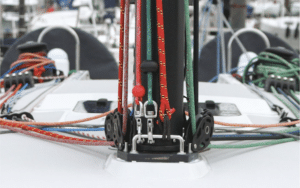Navigating the Seas of Sailing Terminology: A Comprehensive Guide For Yacht Chartering
Sailing, the age-old art of harnessing the power of the wind to cross oceans, has captivated the human imagination for centuries.
Beyond its romantic allure, sailing is a discipline steeped in a unique vocabulary, a common lexicon that helps sailors communicate efficiently and navigate safely with others.
Going on a yacht charter is a great way to get introduced to sailing in all its wonder and excitement. If you’re just stepping aboard, it’s a great idea to learn the ropes. For greater enjoyment and to join in on the experience, understanding sailing terminology adds to the fun.
Following, we’ll dive into the fascinating world of sailing jargon.
1. Bow and Stern The front of a sailboat is called the bow, while the rear is known as the stern. These terms are used for directional reference and are crucial for communication among crew members. An easy way to remember this is that you bow forward.
2. Port and Starboard Rather than using “left” and “right,” sailors refer to the left side of the boat as “port” and the right side as “starboard.” This avoids confusion, especially in situations where clear communication is essential for safety. A trick to remember port from starboard is that the word port has four letters just like the word left, so the port side is the left side of the boat (as you face the bow)
3. Windward and Leeward “Windward” refers to the side of the boat facing the wind, or the side of the boat the wind is passing over, while “leeward” is the opposite side sheltered from the wind. These terms are vital for making tactical decisions while sailing and are often used in racing scenarios.
4. Tacking and Jibing You tack a boat when you are sailing into the wind and want to change directions. “Tacking” involves turning the bow of the boat through
Notice you are always on an angle to the wind to be able to move the sailboat forward. You cannot sail directly into the wind or the sails stall.
When the wind is coming from behind you and you want to turn the boat to a different direction you will perform a jibe. “Jibing” is a similar maneuver but involves turning the stern of the boat through the wind. You will move both the jib and the mainsail to the other side of the boat when you perform the jibe. Both maneuvers are used to change direction and are fundamental to sailing upwind and downwind, respectively.
5. Hull The hull is the main body of the boat that floats on the water and is designed to keep water out. It can be monohull (single hull) or multihull (such as a catamaran with two hulls). The hull’s design impacts a boat’s stability, speed, and maneuverability. A boat hull can be made of fiberglass, wood, or metal. Most hulls these days are made of fiberglass and resin.
6. Rigging The rigging on a boat refers to the system of mast, boom, spreaders, standing wire that holds the mast in place, and lines (ropes) used to support and control the sails. It’s a complex network that enables sailors to adjust the sails to harness the wind effectively. There are different configurations of rigging and each is specific to the design of a boat.
7. Sails Sails are the heart and soul of sailing. The “mainsail” is the largest and primary sail, while “jibs” and “genoas” are smaller sails located at the bow. Adjusting the sails’ position and angle is essential for controlling the boat’s speed and direction.
8. Keel The keel is a heavy structure at the bottom of the hull that provides stability and prevents the boat from sliding sideways due to the force of the wind or tipping over. This is referred to as a boat’s ballast. Some keels are retractable or swing-keels, allowing for flexibility in different sailing conditions, others are fixed.
9. Boom The boom is part of the rigging but important to note separately as you need to be aware of this on a sailing yacht. This is a horizontal spar attached to the mast at the foot of the mainsail. It helps control the shape of the sail and is an essential component in preventing the sail from flapping uncontrollably. The boom usually extends into the cockpit where people sit so when jibing or tacking, it’s important to be aware of this so you don’t get knocked in the head with the boom as it swings.

11. Heeling Heeling refers to the motion of the boat when it is leaning to one side due to the force of the wind on the sails. A sailboat naturally heels and is sometimes uncomfortable for people because they think they might tip over. Sailing yachts with fixed keels and correct ballast will not tip over under normal conditions. Controlled heeling can improve a boat’s performance, but excessive heeling can compromise stability.
12. Draft Draft refers to the depth of the boat’s keel below the waterline. It impacts a boat’s ability to navigate shallow waters and its resistance to tipping over.
13. Knot In sailing, a knot refers to a unit of speed (nautical mile per hour). A nautical knot is equal to about 1.15 mph.
14. Nautical Knots In sailing there are specific knots used for securing ropes. Different types of knots serve various purposes, from securing sails to tying the boat to a dock. The most popular knots are BOWLINE, CLEAT HITCH, CLOVE HITCH, HALF HITCH. Grab some line and click this link to try your hand at some nautical knots.
15. Points of Sail Sailors refer to different angles of the boat relative to the wind as “points of sail.” These include:
close-hauled (sailing as close to the wind as possible)
beam reach (sailing perpendicular to the wind)
broad reach (sailing at an angle away from the wind)
running (sailing with the wind directly behind)
16. Tides and Currents Tide is the rise and fall of the sea level caused by the gravitational pull of the moon and the sun. Current is the horizontal movement of water due to various factors. Both tide and current significantly affect a boat’s movement and navigation. San Francisco Bay has interesting tides and currents as water moves from the Delta into the Bay while the ocean tides move through the Golden Gate Bridge. The currents can run as fast as 5.5 knots through the Golden Gate Bridge.
17. Buoy Buoys are floating markers used to indicate hazards, navigational channels, and other points of reference.
They come in various shapes, colors, and configurations, each with a specific meaning. When you are sailing past them on the Bay you often see a group of sea lions sunning themselves on the buoys.
These mark shallow waters, rocks, shipping channels and many other things sailors need to pay attention to.
Sailing terminology forms the backbone of effective communication among sailors and ensures safe navigation on the open seas. Understanding these terms not only facilitates clear communication but also opens the door to a deeper appreciation of the art and science of sailing. Whether you’re aiming to embark on your own nautical adventures or simply wish to unravel the mysteries of maritime lingo, delving into sailing terminology is a voyage worth taking.
If you’re chartering a boat from us for any of your work or personal occasions, you can learn the ropes while on board with our captains and crew.



